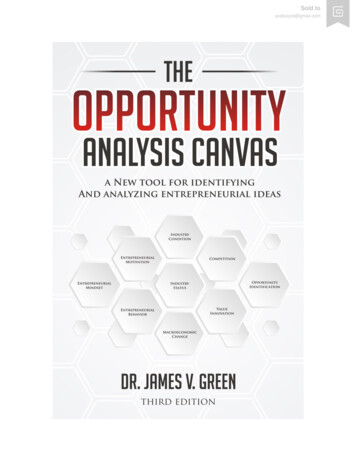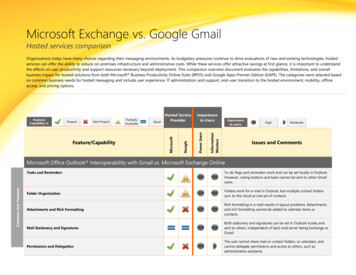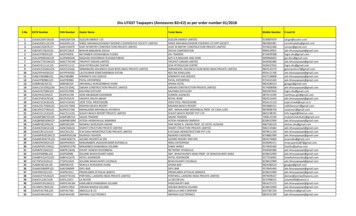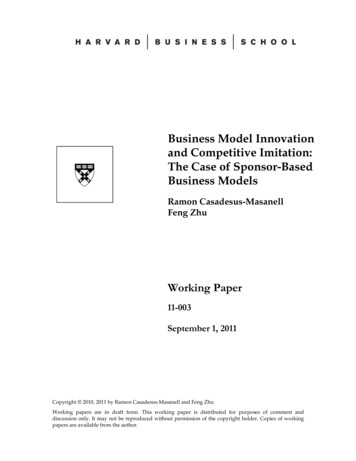
Transcription
Sold toavatazjoe@gmail.com
The Opportunity Analysis CanvasThe Opportunity Analysis CanvasThird EditionDr. James V. Green1
The Opportunity Analysis CanvasCopyright Venture Artisans, LLC, 2015All rights reserved. No part of this product may be reproduced, scanned, or distributedin any printed or electronic form without permission.Publication DataGreen, James V.The opportunity analysis canvas / James V. GreenThird edition1. Entrepreneur2. InnovationISBN: 978-1-50-598363-02
The Opportunity Analysis CanvasFor Jamesia and Ally.Thank you for giving me the opportunity everyday to be a husband and dad.3
The Opportunity Analysis CanvasAbout the AuthorAn award-winning educator at the University of Maryland, Dr. James V. Greenleads the education activities of the Maryland Technology Enterprise Institute. As itsdirector of Entrepreneurship Education, he leads undergraduate and graduate coursesin entrepreneurship, innovation, and technology commercialization. He has created andled a host of innovative programs and activities serving over 600,000 entrepreneurs andinnovators from over 175 countries. With more than twenty publications to his credit, heis a thought leader in entrepreneurship education.In 2011, he earned first prize in the 3E Learning Innovative EntrepreneurshipEducation Competition presented at the United States Association for Small Businessand Entrepreneurship (USASBE). In 2013, he launched the University of Maryland’sfirst MOOC with Coursera’s “Developing Innovative Ideas for New Companies”.Prior to joining the University of Maryland, Dr. Green held founder, executive,and operational roles with multiple startups to include WaveCrest Laboratories (aninnovator in next-generation electric and hybrid-electric propulsion and drive systems;acquired by Magna International, NYSE: MGA), Cyveillance (a software startup andworld leader in cyber intelligence and intelligence-led security; acquired by QinetiQ,LSE: QQ.L), and NetMentors.Org (the first national online career developmenteMentoring community).Dr. Green earned a Doctor of Management and an MS in TechnologyManagement from the University of Maryland University College, an MBA from theUniversity of Michigan, and a BS in Industrial Engineering from the Georgia Institute ofTechnology.4
The Opportunity Analysis CanvasContentsChapter 1. IntroductionChapter 2. What are Entrepreneurial Opportunities?Chapter 3. What is Strategic Decision Making?Chapter 4. Part 1 - Thinking EntrepreneuriallyChapter 5. Entrepreneurial MindsetChapter 6. Entrepreneurial MotivationChapter 7. Entrepreneurial BehaviorChapter 8. Part 2 - Seeing EntrepreneuriallyChapter 9. Industry ConditionChapter 10. Industry StatusChapter 11. Macroeconomic ChangeChapter 12. CompetitionChapter 13. Part 3 - Acting EntrepreneuriallyChapter 14. Value InnovationChapter 15. Opportunity IdentificationChapter 16. Next Steps5
The Opportunity Analysis CanvasChapter 1. IntroductionThere is nothing more powerful than an idea whose time has come.Victor HugoPoet, Novelist, and Dramatist112,788.At the time of this writing, this is the number of results when searching for businessplan books on Amazon.com. As we need the business idea before writing the businessplan, aspiring entrepreneurs require insight and direction on how to identify and analyzeentrepreneurial ideas. This book stands alone in its focus on integrating entrepreneurialthinking, seeing, and acting upon entrepreneurial opportunities. It will help you find thatidea from which to build a company.What is an opportunity?In this context, the term opportunity refers to the potential to create a new venture.This can be a for-profit company, a non-profit company, a venture within an establishedcompany or organization, or any related venture that creates value for the customers andthe owners of the venture.Why are there millions of missed opportunities?In retrospect, we all recognize good opportunities. It’s easy to see the successes ofothers, and believe that we could have achieved similar success had we acted on our ownpast ideas. Our decisions, however, are of most value in the present, and not in hindsight.Each year, over one million students enroll in entrepreneurship courses worldwide.Estimates suggest that less than 2% of these students actually launch a business. Why areso few students launching businesses? While many are interested in simply learning skillsfor future use, a significant number desire to launch a new venture in the near term. Thismismatch of entrepreneurial ambitions versus actually launching ventures exists forstudents of all ages.What’s missing?There is the need for something new, something different, that helps us identify andanalyze entrepreneurial opportunities. For aspiring entrepreneurs, new tools are necessaryto develop the ideas that can lead to effective business planning and successful ventures.Is the business model approach the key?The business model is the precursor to the business plan. The emergence of businessmodel courses and competitions in universities, in lieu of prematurely writing businessplans, are steps in the right direction. The focus of these new business model courses andactivities is to engage aspiring entrepreneurs in customer discovery early. An emphasis isplaced on testing their major hypotheses of the business model before investingsignificant effort and capital into creating the business plan or the business itself.6
The Opportunity Analysis CanvasWhile this is a viable approach, and a valuable lesson in entrepreneurship education,business models can only begin to take shape after a new venture idea is formulated.Customer discovery requires having a product or service concept to test.What is the Opportunity Analysis Canvas?The Opportunity Analysis Canvas is based on my experiences of teaching over600,000 students and advising hundreds of companies including multiple Inc. 500 awardwinners.The canvas began nearly eight years ago with my doctoral dissertation titled“Educating entrepreneurship students about opportunity discovery: A psychosocialdevelopment model for enhanced decision-making.” While this dissertation title maysound complicated, the basic idea is that before drafting business models and writingbusiness plans, aspiring entrepreneurs need to see and think about problems and solutionsdifferently than others.As I explored this topic of entrepreneurial opportunity analysis, I recognized a patternthat could be identified. With that identification and understanding, I saw that it is aprocess that could be taught.Before beginning this book, over many years at the University of Maryland, I testedvarious ideas and approaches of teaching. These activities engaged thousands of mystudents in readings, assignments, projects, and mentoring that led to dramaticimprovement in their entrepreneurial opportunity identification and analysis skills.The outcome of this opportunity analysis journey, and the proven success of itsteaching, is this book. It is my hope that by understanding the principles and patterns ofthe Opportunity Analysis Canvas you will become more effective in identifying andanalyzing entrepreneurial opportunities, and realizing your personal and professionalgoals.The Opportunity Analysis Canvas is a new tool for identifying and analyzingentrepreneurial ideas. Structured as a nine-step experience, the canvas is segmented into:thinking entrepreneurially with an entrepreneurial mindset, entrepreneurial motivation,and entrepreneurial behavior; seeing entrepreneurially with industry condition, industrystatus, macroeconomic change, and competition; and acting entrepreneurially with valueinnovation and opportunity identification.7
The Opportunity Analysis CanvasThe Opportunity Analysis CanvasWithout the idea for the product or service, neither business model nor customerdiscovery can begin. It is this first step of defining the idea that the Opportunity AnalysisCanvas aims to fulfill.How can I use this book?This book’s structure aligns with the Opportunity Analysis Canvas, as each of thenine steps is addressed in a dedicated chapter. The focus of each chapter is to firstintroduce you to the topic. This provides a background on the subject and describes itsrelationship to entrepreneurship. Tools including research databases and referencematerials are highlighted. Tips and techniques are then presented for how to develop yourskills and knowledge. A featured entrepreneur is then profiled. Lastly, challengequestions are posed for you to develop your opportunity analysis abilities.These nine steps are explored in three parts.Steps 1 – 3: Thinking entrepreneurially. Thinking in this context is influenced byindividual mindsets, motivations, and behaviors. Part I addresses these first three steps ofthe Opportunity Analysis Canvas. This sets the stage for the subsequent chapters onseeing entrepreneurially.Steps 4 – 7: Seeing entrepreneurially. Part II examines seeing entrepreneurially,which requires that you have a “big picture” perspective. This means that you recognizeand understand the economic forces impacting your ideas as well as industry andcompetitive factors that exist now and in the future. With dedicated chapters on industrycondition, industry status, macroeconomic change, and competition, each of these steps is8
The Opportunity Analysis Canvasexplored in detail.Steps 8 – 9: Acting entrepreneurially. As you develop your abilities to think and seeentrepreneurially, you are better prepared to act. With attention to value innovation andopportunity identification, your entrepreneurial ideas can be transformed into action.9
The Opportunity Analysis CanvasChapter 2. What are entrepreneurial opportunities?Don't start a company unless it's an obsession and something you love. If you have anexit strategy, it's not an obsession.Mark CubanAmerican businessman, investor, and owner of the NBA's Dallas Mavericks,Landmark Theatres, and Magnolia PicturesTo explore the roles of entrepreneurial thinking and opportunity identification, anintroduction to entrepreneurial opportunities is in order.As we examine entrepreneurial opportunities, we’re going to spend this chapterdiscussing the foundational elements of entrepreneurship. We’ll also explore moderninterpretations of the term entrepreneurial opportunities and discuss emergingopportunities.Casson defines entrepreneurial opportunities as “those situations in which new goods,services, raw materials, and organizing methods can be introduced and sold at greaterthan their cost of production.” 1Drucker classifies entrepreneurial opportunities into three categories: “(1) the creationof new information, as occurs in the invention of new technologies; (2) the exploitationsof market inefficiencies that result from information asymmetry, as occurs across timeand geography; and (3) the reaction to shifts in the relative costs and benefits ofalternative uses for resources, as occurs with political, regulatory, or demographicchanges.” 2By all definitions, entrepreneurial opportunities differ from the larger set of generalbusiness opportunities. Entrepreneurial opportunities require the discovery of newrelationships and interactions in the marketplace that are uncertain and dynamic.3,4Differences of opinion by individuals may highlight entrepreneurial opportunities,with some seeing opportunities while others view the same situation with doubt ordisinterest.5,6 Therefore, understanding decision-making in the context of entrepreneurialthinking is central to joining this population that sees opportunities.How have entrepreneurs evolved over history?When we look at the history of opportunity and how humans have created value overtime, and what has been at the forefront of being able to do that, at first it was the hunter,the grower, and the warriors. It then became the craftsmen and the explorers, and themerchants and the mechanizers. It went on to the industrialists. More recently, it’s thecorporate path, the corporate executive. Today, investment banking and private equity arepopular career ambitions.What is the next phase as we think about where great value will be derived? Whereare those individuals with the highest need for achievement going to be attracted?It’s the startup companies. It’s those who can make useful things faster thancorporations. It’s those willing to take larger risks for larger rewards. By being moreinnovative and creating more value in the marketplace, startups will lead the future.10
The Opportunity Analysis CanvasIn addition to full-time entrepreneurs, we see entrepreneurial activities viaindependent contractors and side-preneurs.Independent contractors are gaining a lot of momentum in the U.S. and globally.Outsourcing, traditionally limited to manufacturing and call centers, is taking hold insoftware development and research and development (R&D). There are a variety ofdifferent pieces of the organization that are being outsourced. In many cases, it’s small,entrepreneurial firms that are playing a role in providing that outsourcing.Side-preneurs have a day job, but they also work nights, or weekends, or on their daysoff on independent projects for hire. These projects are typically in their field ofexpertise. They may be employed as a graphic designer by day with a company, butthey’re also going to do graphic design work at night for other individuals outside of theircompany.We’re also seeing entrepreneurship growing via new online communities. Newmarketplaces are emerging whereby for reasonable affordability, entrepreneurs and smallbusinesses, and even large businesses, can contract out jobs to freelancers online todeliver that work. Cumulative transactions for these online communities are in excess ofa billion dollars. There’s oDesk, Elance, Freelancer, 99 designs, and dozens of others.I’ve personally benefited from using a number of these services individually for my ownprojects.When we look at the number of freelancers who are out there, the number of peoplewho are doing graphic design, the number of people who are writing web copy, thenumber of people who are doing computer programming assignments and tasks, the totalnumber exceeds 10 million. When you look at the number of jobs that have been posted,we see tremendous numbers there—millions and millions of jobs posted.The economics work for the freelancer. If you pay a 300 fee to oDesk—to have alogo designed, for example—10% of that will stay with oDesk, and that’s essentiallytheir management fee. The remaining 90% goes to the individual who’s actuallydesigning that logo. This often exceeds their compensation for completing a similarproject as an employee of a large company.Futurists who are thinking about the businesses of the future forecast that many moreof us will become entrepreneurs. They see employee healthcare and financial benefits,pension plans and retirement packages, all disappearing in the future for most employeesof most companies. Everybody’s going to be a free agent, and everybody’s going to be anentrepreneur. You’re going to broker your skills and negotiate your own contracts foreverything. Now it may not reach 100% of companies, but it certainly is an interestingfuture to think about, and it’s an interesting concept to be aware of on the path tobecoming an entrepreneur.Entrepreneurship continues to evolve over time, as do the opportunities thatentrepreneurs pursue.How have entrepreneurial opportunities changed over time?Software and hardware entrepreneurs have monopolized discussions of startups inrecent decades. While Bill Gates, Steve Jobs, Elon Musk, and our modern celebrity11
The Opportunity Analysis Canvasentrepreneurs are creating tremendous products and new markets, they’re neither the firstnor the wealthiest entrepreneurs in history.In the Gilded Age in the U.S. during the late 1800s, new factories, oil production,shipping, lumber, and railroads generated tremendous sums of wealth for entrepreneurs.A top 10 list of entrepreneurs in their day would read John D. Rockefeller, Jay Gould,Henry Clay Frick, Andrew W. Mellon, Andrew Carnegie, Henry Flagler, Henry H.Rogers, J. P. Morgan, Leland Stanford, and Cornelius Vanderbilt.In the century prior, mechanization during the Industrial Age created anothergeneration of entrepreneurs who identified and acted on opportunities. Benjamin Franklinand James Watt were of this class.While the term entrepreneur is popular today, the practice of entrepreneurship hasbeen ever-present in society.Today, we see the influence of entrepreneurs on a global scale. Unprecedentedglobalization is taking place with new access to financial capital, partners, and customers.One way to quantify that is through rising GDP among nations. Heightened wealth and alarger middle class globally can buy items that were once unaffordable. This new middleclass can participate in markets with access to new products and services. Consider theopportunity that this presents to aspiring entrepreneurs.We also see that the adoption rate of new products and new technologies is rapidlyrising. From the time that automobiles, washing machines, and telephones were invented,it took over 20 years for them to reach an 80% adoption rate in the market. Moderntechnologies – cell phones, the Internet, and personal computers – have in a very shorttime span reached 60%, 80%, even 90% market penetration in less than 10 years. Thisrate of adoption of new technologies is unprecedented.Virtual teams and a global network of collaborators are now easier to establish thanever. I can find co-founders and advisors with CoFoundersLab. LegalZoom, in the U.S.,can assist with my corporate formation and provisional patents. I can crowdfund my ideawhile reaching customers globally via KickStarter, and secure equity funding viaCrowdcube in London. I’ll use Elance to hire my development team in the Middle East.With Fiverr I can spend 10 on a logo designed in South America.The globalization of entrepreneurship also brings unparalleled competition. Theseterrific online networks and collaborators are available to your competitors as well. Thoseof us with entrepreneurial ideas need to execute on them reasonably soon. A good ideanow will be someone else’s business later if you don’t execute.We will examine how to be better, faster decision makers. We will discuss how tobring our ideas to market quickly, and how to leverage the changes taking place with newtechnologies and new products, to capitalize on the globalization of entrepreneurship.What is Amazon.com’s approach to entrepreneurial opportunities?The history of Amazon is a great example of how to identify and act onentrepreneurial opportunities. In 1994, Amazon set out to sell books on the Internet at anaffordable price and with a selection of titles as vast as the Amazon rainforest. A decadelater, Amazon was a leader in printed books and CD-based music. It soon became a12
The Opportunity Analysis Canvasleader in DVD sales as well.Today, 43% of their sales are from media and digital goods, not their historicstrongholds of physical products. Amazon is not waiting. They did not wait to see whatwould happen with eBook adoption in the marketplace. They did not wait long to seewhat happened with online music. They’re not waiting to see what happens withstreaming music, and media, and television, and movies. They’re leading the charge.We will explore what they’ve done to enter new markets, be leaders in these spaces,and not be comfortable as the successful incumbent. Amazon is an interesting companyto examine, and a company that we will continue to explore in this book.What is our approach to studying entrepreneurial opportunities?Entrepreneurial opportunities differ from the general set of business opportunities.There are new relationships that are uncertain and dynamic. There are always newplayers involved. There is a race to bring new products and technologies to market.I aim to help you understand that opportunity identification is a critical first step tosuccess as an entrepreneur. Together, we will improve your ability to see entrepreneurialopportunities and make entrepreneurial decisions. You will be better prepared to makedecisions that have significant consequences quickly and comfortably. You can moreconfidently take the necessary steps to capitalize on your entrepreneurial ideas.When we discuss entrepreneurial opportunities, this is a term that is well entrenchedin universities and research centers, and widely studied in recent decades. I will bringinformation to you from the academic arena as well as from the practical arena based onmy experience as a founder, executive, adviser, and investor with startup companies.Through this book, you can validate or enhance opportunities that you are alreadyconsidering, and identify new entrepreneurial opportunities.Decision making is the foundation for entrepreneurial success. While we could skipthis topic of decision making, and dive into how you create business models or marketingplans, we recognize the value of decision making and the importance of the entrepreneurin entrepreneurship. It all starts with the entrepreneur. For us, the next step is a discussionon strategic decision making.13
The Opportunity Analysis CanvasChapter 3. What is strategic decision-making?When you’re first thinking through an idea, it’s important not to get bogged down incomplexity. Thinking simply and clearly is hard to do.Richard BransonFounder of Virgin Group (400 companies including Virgin America, Virgin AtlanticAirways, Virgin Cola, Virgin Galactic, Virgin Media, Virgin Mobile, Virgin Money, andVirgin Records)As we examine decision making, and specifically strategic decision making, we’llexplore the term in an entrepreneurial context. We’ll continue our discussion of Amazon,and the elements that motivated them to select the product categories that they beganwith. We’ll also introduce the concept of cognition, and connect cognition to theentrepreneurial process.Decisions typically share a similar path. We recognize a problem. We generatealternatives. We evaluate those alternatives. Then, we select the alternative that bestsatisfies our evaluation criteria. This is true for many different types of decisions,including major personal decisions such as buying a home or an automobile. Strategicprofessional decisions include career changes. Entrepreneurial decisions include what tolaunch, if to launch, and how to launch our venture.In the beginning of the venture, nearly all decisions are strategic: when you’reevaluating the idea, when you’re thinking about the concept, when you’re developing theprototype, when you’re testing that with customers, and when you’re considering if youneed to raise funding.Before bringing your product to market, strategic decisions include: Who should be your co-founders? What should you focus on in your marketing plan? How do you build the product? Where do you build it? What do you spend on building it?What was Amazon.com’s first strategic decision?As an example of entrepreneurial strategic decision making, consider the idealproduct to sell online in 1994. The answer would be quite different than what it would betoday.In 2015, we have decades of experience and research on online sales. We havemillions of articles, reports, magazines, case studies, and books on online sales. There areeven movies based on entrepreneurial success stories for online businesses, to includeThe Social Network in 2010, adapted from Ben Mezrich’s 2009 book The AccidentalBillionaires: The Founding of Facebook.In 1994, at the birth of online retailing, research materials were very scarce. Therewere general business principles that made sense, such as thinking strategically aboutwhat could I sell online, and that online retailing presented possible advantages to bricks14
The Opportunity Analysis Canvasand mortar retailing. There was a question of convenience. Was it something thatcustomers needed immediately? Was shipping affordable for certain product types?Could customers envision the product without seeing it in person?There are other factors in the mid-1990s that made the Internet different than it isnow. Security is one. If I’ve never bought anything online, am I willing to enter my creditcard information online? Am I willing to buy things from companies I’ve never heard of?And what’s the consequence of that? As a consumer, am I willing to risk 10? 100?When we look at these considerations, we ask, what’s the ideal product to sell online?For Amazon, it was books first and music second. Specifically, printed books andCDs made sense. We’ll talk about why they made sense.One element was the competition in books and music retailing, which wascharacterized by a large, fragmented market. There were the mall retailers likeWaldenbooks, B. Dalton, Crown Books, Sam Goody, Musicland, Suncoast and others inthe U.S. But with no major players, competition was widely distributed.Books and music were also attractive online products to retail because you knewexactly what you were getting when you ordered a certain title online. We did not need totry it on or taste it. It wasn’t a consumer electronic device that you wanted to see workingin the store, or see the quality of the picture before we bought a television. We knew thatif a book was from a certain author and a certain title, or that a CD was of a certain albumfrom a certain artist, it would be exactly what we expected.Searching was very easy to do as well. Books and music did not come in multiplesizes, multiple widths, and multiple colors. As consumers, we could easily search andfind what we were looking with books and music.Books and music brought large market opportunities for Amazon. What this means isthat millions of Americans read books, and many more listened to music.There was an element of product branding that Amazon was able to leverage andintegrate. Even though people did not know what Amazon was then, they knew the booksthat they loved and the music they loved. They knew John Grisham, Tom Clancey,Stephen King, Madonna, and Michael Jackson.By bypassing the bricks-and-mortar expenses, there was a cost advantage. Amazonsaved retail space cost and associated labor cost. They could share those savings withcustomers.Shipping costs for books and music was inexpensive.Books and music made a lot of sense as an online purchase in the mid-1990s.Even with these advantages, if you’ve studied Amazon, you know that it took until2003 to achieve profitability. They built tremendous market share and an incredible brandalong the way.But they didn’t stop there.The books and the music of the 1990s was where they started. They’ve done infinitelymore things since then, particularly in the digital space, as we’ll discuss. Remember thatit started with a very strategic decision of doing one simple thing well, selling booksonline.15
The Opportunity Analysis CanvasWhat are the characteristics of strategic decisions?When we discuss strategic decisions, there are four fundamental characteristics toconsider. These are: Complexity - What really makes a decision strategic is that it’s complex. There arelots of facts, variables, and alternative choices. There’s not an easy answer. Uncertainty - We don’t know the eventual outcome. We can anticipate and planand forecast, but we’re not sure. So, there is an element of the unknown. Rationality - There are limits of rationality to consider. What are our goals? Whatare our objectives? Control - We can control, or at least influence, some factors, albeit not all.In this way, when we think about strategic decisions, these four characteristics comeinto play.Why is decision making a cognitive process?For our purposes, we can think of cognition and thinking as synonyms. Entrepreneursask, “What are my resources? What’s a course of action that I’d like to pursue? What arethe results that I desire? What do I do as things change?”.As entrepreneurs, we always have choices. There are multiple alternatives at everystage. There is the option of not doing anything and waiting to see what happens. There’san element of choice that is implied with decision making.Decision making is a strategic activity. As an entrepreneur, you will need to set yourrevenue goals and your profit goals, and create your marketing plans and hiringstrategies. Every strategic decision is influenced by your own comfort level with the riskinvolved with that decision. Your personal mindset, motivations, and behaviors guideyour decision making.Strategic decisions demand critical analysis. They involve consideration of requiredresources and commitment levels, and expected risks and rewards.Jeff Bezos, the founder of Amazon, introduced an incredible and lasting phenomenonwith his company. Granted, it’s easy to look at entrepreneurs after they have had success,and hear them tell you how right they were, how they made all the right decisions, andhow they have had this wonderful success. It’s rare to be able look at entrepreneurs whoare successful before they became successful.To see them fifteen or twenty years prior, when they were just beginning to build theirsuccess. What their decision making and thought processes were then, and what theyexpected to happen. And in that way, we have the benefit of understanding the future andknowing the future. We see what happened according to plan, and see what wasmodified, or adapted. Historic video interviews and articles can provide us with thisretrospective lens, and we see that Jeff Bezos was an innovative, prophetic thinker fromthe start.I invite you to view “The Jeff Bezos of 1999: Nerd of the Amazon” on the CBS Newswebsite. This video is available -1999-nerd-of-the-amazon/.16
The Opportunity Analysis CanvasWhy study strategic decision making?We all need to be better entrepreneurial decision makers. Through this book, we canunderstand what’
Management from the University of Maryland University College, an MBA from the University of Michigan, and a BS in Industrial Engineering from the Georgia Institute of Technology. The Opportunity Analysis Canvas 5 Contents Chapter 1. Introduction . In addition to full-time entr










